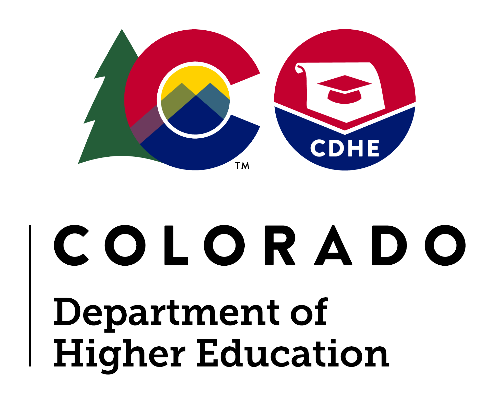The Colorado Department of Higher Education (CDHE) released its annual Return on Investment
(ROI) report, providing a comprehensive analysis of how Colorado’s public colleges
and universities are preparing students for successful careers and long-term economic
mobility. The ROI report helps lawmakers, taxpayers, students, and families understand
the value of postsecondary education in Colorado.
The report also highlights legislative wins and promising practices introduced in
Colorado in recent years that positively impact postsecondary student ROI and workforce
readiness.
- Colorado Promise: Two Free Years of College Expanded assists resident students who have family incomes of $90,000 or less with a tax credit reimbursement of any out-of-pocket tuition and fees paid during a student’s first 65 credits toward their higher education at any Colorado public institution. By reimbursing out-of-pocket costs for eligible students, this program has the potential to reduce student debt and improve ROI.
- Programs like FosterEd and EmpowerEd cover the cost of attendance for former foster youth and students who have experienced homelessness.
- Colorado’s Open Educational Resources (OER) Grant Program has saved Colorado students more than $42.1 million on textbook costs and transformed over 1,900 courses to no cost by creating, adapting and adopting free openly licensed educational resources at campuses across the state.
- This year, the legislature passed and Gov. Polis signed HB25-1186: Work-Based Learning Experiences in Higher Education. This collaborative effort seeks to advance a student’s return on investment by embedding work-based learning into a student’s curricular experience, which will help more students get work ready and maximize the value of their degree.
This year’s report examines postsecondary outcomes across credential types, programs,
institutions and student demographics from the 2022-2023 academic year. The report
evaluates earnings years after graduation, alongside student debt levels and employment
trends across the state.
The report specifically looks at several important measures, including:
- How long it takes to finish college and how many credits students take;
- How much college costs and how much debt students have when they graduate; and
- How much money graduates earn after college.
Key takeaways
- Average Cost to Complete a Certificate or Undergraduate Degree: Because the state and its institutions are committed to affordability for in-state students, many students—particularly those from low-income families—pay little, if any, tuition, and end up with a significantly lower net price overall. Almost all students whose annual family income is less than $75,000 and who apply for aid receive some type of financial assistance, with Colorado Promise providing a tax credit for eligible students with family incomes below $90,000.
- Enrollment and Completion: The total number of resident students enrolled in Colorado’s certificate and undergraduate programs at public institutions has declined from pre-pandemic levels, but the decrease showed signs of stabilizing in 2022 (the most recent data available). During the 2022-23 academic year, public institutions awarded 17,938 certificates, 9,121 associate degrees and 21,171 bachelor’s degrees to resident students.
- Average Student Loan Debt: Student debt among residents graduating from Colorado public institutions has been on a steady downward trend, as only 43% of combined associate and bachelor’s degree graduates had debt in the 2022-23 academic year, compared to 61% in the 2013-14 academic year. When combining declining average loan amounts with lower rates of completers with debt, the total debt burden for Colorado public institution graduates has significantly improved over time. After adjusting for inflation, total debt for associate and bachelor’s degree graduates exceeded $400 million between the 2013-14 and 2016-17 academic years. Subsequent levels have steadily declined and dropped below $250 million in the 2022-23 academic year.
- Employment Rates: Data consistently shows that higher levels of educational attainment are strongly related to a greater likelihood of employment, lower rates of unemployment, and higher lifetime earnings.
- Wage Outcomes: While median earnings show little variation between credential types one year after graduation, the earnings gap widens significantly over time, with bachelor’s degree graduates experiencing the fastest 10-year growth rate at 50.5%, followed by associate degrees at 35.6% and certificates at 26.2%.
“The ROI report remains a vital tool for students, families, policymakers and educators
as they navigate the landscape of higher education and workforce,” said Dr. Angie
Paccione, executive director of CDHE. “The data confirm what we’ve long known, investing
in higher education leads to stronger individual outcomes and a more resilient Colorado
economy.”
The report also includes data dashboards and student-friendly tools to help Coloradans make
informed decisions about college and career paths.
About the report
To inform lawmakers, taxpayers, and students on the value of postsecondary education
in Colorado, CDHE publishes an annual return on investment report. The report was
submitted to the Senate and House Education Committees of the Colorado Legislature,
pursuant to 23-1-135 C.R.S.
About the Colorado Department of Higher Education
Working with the Colorado Commission on Higher Education, we support students, advocate
and develop policies to maximize higher education opportunities for all. The Department
believes every Coloradan should have an education beyond high school to pursue their
dreams and improve our communities. Read the strategic plan, Building Skills in an Evolving Economy.

